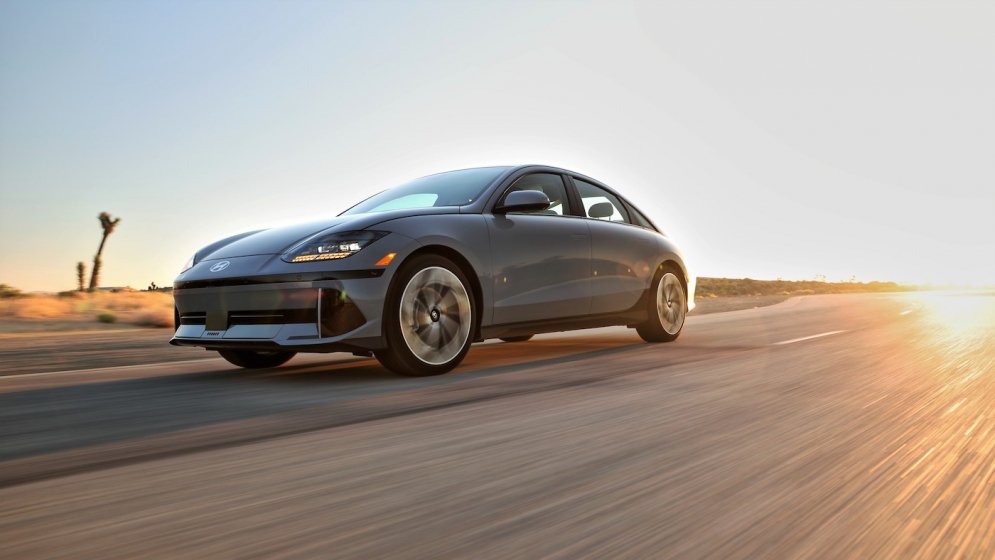LOOKS
The exterior of the Ioniq 6 features a head-turning design unique from other sedans, one that is focused on improved aerodynamics. It’s highlighted by a flowing roofline, and distinct front and rear designs.
While there may be a few detractors, I believe most people will fall on the side of loving the design, which I found to be quite stylish in addition to aiding efficiency.
All four door handles, in typical EV style, are embedded in the doors and come out when you unlock the vehicle.
My test vehicle featured 18-inch wheels and LED headlights and taillights. Some trim levels feature 20-inch wheels.
Moving inside, the interior design is not at a luxury level, but it is still somewhat upscale, and proves to be roomy for all five passengers with lots of leg room and head room.
Cargo space suffers, though, compared to other EVs in the class. If you are interested in more cargo space and like Hyundai’s overall style, you can upgrade to the Ioniq 5 SUV.
Small storage space is strong, though, including a helpful extra shelf right below the center console. The Ioniq 6 also featured a sparse, minimalistic setup with the window and door controls in the middle of the vehicle, and almost nothing on the door interiors.
Features included heated front seats, leather-wrapped steering wheel, rear air vents, and a power drive seat with lumbar support, digital instrument panel, and 60/40-split folding rear seats. Seating is either cloth or synthetic leather.
HOW’S THE RIDE?
The Hyundai Ioniq 6 that I tested featured a single, rear-mounted electric motor, 77.4-kWh battery, and delivered 225 horsepower and 258 pound-feet of torque. Range was an impressive 361 miles.
The base model comes with a 53 kWh battery, and horsepower drops to 149. Range on this version is 240 miles.
And the power tops out with dual-motor versions offering 320 horsepower and 446 pound-feet, and all-wheel drive, and a range of up to 316 miles.
So depending on your lust for power, you have several options to consider.
In any form, the Ioniq 6 is a very quiet ride, and even sounds like a spaceship if you cruise around without the radio on.
And as far as the ride quality, even without the most powerful option I found the Ioniq 6 to offer a tremendously enjoyable, even fun, driving experience. It offers plenty of power and instant torque that will get you moving quickly. The AWD Long Range version will go from 0-to-60 in under 5 seconds, while the RWD Long Range will be closer to 6 seconds.
With impressive handling and a smooth overall driving feel, plus all of its EV bonafides, the Ioniq 6 offers one of the best driving experiences of any EV currently on the market.
TECHNOLOGY, SAFETY
The Ioniq 6 infotainment setup is centered around a 12.3-inch infotainment screen also found on many other Hyundai vehicles. It’s wide, full of information and easy to master.
Touch climate controls are located below the touchscreen. But in one odd twist, to turn heated seats on or off, you must use the touchscreen and go through some menus to access the command.
The touchscreen features so many menus it will take drivers a while to absorb all the possible controls, and it’s likely they’ll never use many of them.
If you’re not a fan of using touch commands, voice commands worked very well in the Ioniq 6 and I didn’t experience any major hiccups in comprehension for radio, navigation and phone commands.
Bluetooth connection allows for streaming calls and music from your phone, and Apple CarPlay and Android Auto allow for phone mirroring (though not wirelessly, which is out of step with most competitors). A 90-day trial of satellite radio is included with the vehicle.
Hyundai’s Digital Key feature also allows you to use compatible smartphones as a key to the vehicle.
In terms of safety, Hyundai has you covered with a bevy of systems that function without any major concerns.
The lane keeping system works quite well to provide a limited self-driving capability, even slowing itself down via adaptive cruise control. The system worked well even on windy roadways, staying within lines.
Other important safety features included a helpful rearview monitor, plus the option to upgrade to an even more helpful surround-view camera system that delivers a top-down view of the vehicle and all surroundings for tight parking situations.
Other systems included are: Forward Collision-Avoidance Assist, Blind-Spot Collision Warning, Rear Cross-Traffic Collision-Avoidance Assist, Automatic Emergency Braking with Pedestrian Detection and Parking Distance Warning.
The vehicle will give a Driver Attention Warning if it thinks you’re drowsy or not paying attention enough to the road, and a Rear Occupant Alert warns you not to leave anyone in the vehicle.
All this together has given the Ioniq 6 some of the best government safety ratings available.
RANGE, CHARGING
Hyundai has come through with impressive range and MPGe numbers on the Ioniq 6, setting itself up for success in the growing EV market.
The vehicle offers 140 MPGe combined (153 MPGe city/127 MPGe highway). Its annual fuel cost is estimated at $500, which will save the average driver more than $1,000 each year.
With an official range of up to 361 miles, the Ioniq can claim a higher range than all of its competitors, and is only beaten in total range by a few much more expensive luxury EVs. If you don’t drive long distances daily, you can in theory just charge it overnight at home once or twice a week, and never have to worry about whether you’ll get where you need to go.
Combining that range with a lower price means that it’s realistic that the Ioniq 6 could see widespread adoption as people seek alternatives to Tesla in the EV market. Range anxiety is one thing that has held back some people who were interested in EVs, but these numbers will end that anxiety.
As far as charging, home charging with a Level 2 charger can be done overnight, but if you use public chargers it’s compatible with powerful 350-kW DC fast-charging stations that will make for speedy juicing-up periods. At the public charger I used during my testing period, the Ioniq 6 went from 31 percent to 80 percent in 36 minutes.
Regenerative braking while you drive helps to keep up the charge in the Ioniq 6, and one thing I liked was that using the climate controls to heat up your car won’t plunge the range steeply like I’ve seen happen in other EVs.
PRICE
My Ioniq 6 test vehicle was priced at $46,825, and the base price starts around $38K. That’s smart pricing as they battle for market share, as it comes in several thousand below the Tesla Model 3, and over $10K below the BMW i4 and Polestar 2 EVs.
The Ioniq 6 also comes with two free years of 30-minute charging sessions at Electrify America fast-charging stations.
It comes in four trim levels: SE Standard Range, SE Long Range, SEL and Limited. The top trim level puts you into the low $50K range.
Warranties are industry leading from Hyundai, including:
— 10-year/100,000-mile EV system and powertrain warranties
— 5-year/60,000-mile new vehicle warranty
— 3 years/36,000 miles of free maintenance
— Free roadside assistance for 5 years/unlimited miles
BOTTOM LINE
The Hyundai Ioniq 6 is without question one of the top electric vehicles to hit the market. It offers plenty of range, is tech-savvy, looks sharp, is fun to drive, and is not extremely expensive like so many rivals are.
The Ioniq 6 has the potential to be an EV leader for many years to come, and a key vehicle in their portfolio as Hyundai seeks to become a major player in the EV landscape — and aims to become one of the mainstream brands carving out some of the EV market share long held by Tesla.
===
AutoTechReviews.com can be found on Twitter @AutoTechReview, or stay updated at the AutoTechReviews Facebook page. Follow AutoTechReviews on Instagram at @Autotechreviews. Matt Myftiu can be found on Twitter @MattMyftiu




